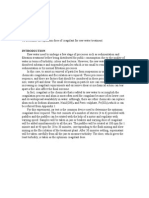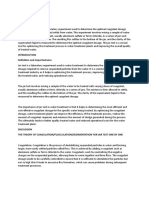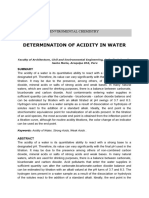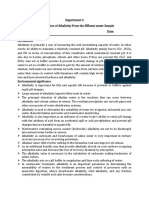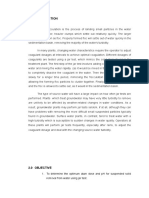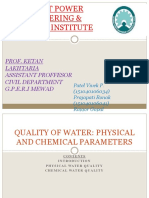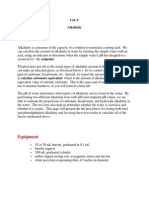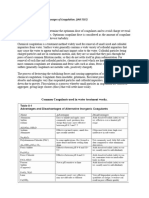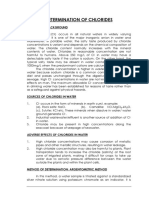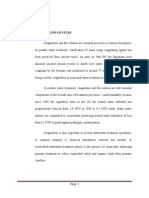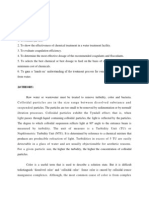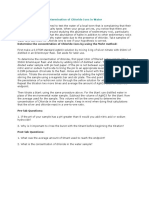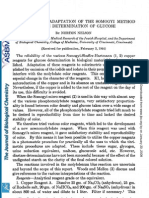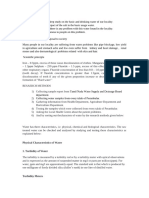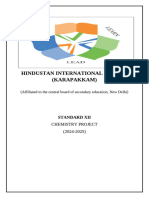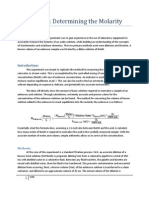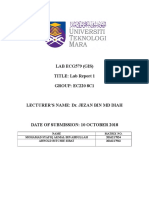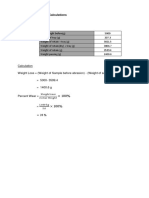Conclusion
Conclusion
Uploaded by
Mohd Syafiq AkmalCopyright:
Available Formats
Conclusion
Conclusion
Uploaded by
Mohd Syafiq AkmalOriginal Description:
Original Title
Copyright
Available Formats
Share this document
Did you find this document useful?
Is this content inappropriate?
Copyright:
Available Formats
Conclusion
Conclusion
Uploaded by
Mohd Syafiq AkmalCopyright:
Available Formats
Discussion
Based on the data and observation, the alum dosage increased in the beakers from
number 1 to 6, which is from 0 to 5ml and the jar 0 ml is act as control. For this water sample,
as the dose of coagulant increased the residual turbidity improved. The addition of excess
coagulant may reduce turbidity beyond what is required but also could lead to the production
of more sludge which would require disposal.
When coagulant is added into the water, it helps to promote coagulation. The coagulant
encourages colloidal material in the water to join into small aggregates or flocs (microfloc).
Coagulant neutralizes the electrical charges of particles in the water which causes the
particles to clump together. Properly formed floc will settle out of water quickly in the
sedimentation basin, removing most of the water's turbidity. Hence impurities can be easily
removed. Thus, from the data, the colour of water decreases from 380 to 332 Pt0 as the
volume of alum increases.
After analysing the data, from the graph the optimum dosage for coagulant is 40mg/l, which
is the lowest turbidity 7.47 NTU, with pH value 6.54. However, it is important to note that
turbidity was not reduced with the increasing amounts of alum dose because the coagulant
added more particles to water to be treated at the lower doses.
On the other hand, the strong acid behaviour of the alum addition causes the pH value
decreased and demised alkalinity. Which from the data given, the value of final pH is
decreasing from 7.15 to 6.37? It is because the change in pH in the water being treated
depended on the coagulant dosage. Therefore, it can conclude that the higher alum dosage,
the lower the pH value, which means that the alkalinity may be decreased.
Conclusion
From the experiment, it can be concluded that the optimum alum dosage which will result in
the lowest turbidity is 40mg/l, with a turbidity of 7.47. Next, it was also shown from the
experiment that the pH and colour value will be lower when the alum dosage is higher. Since
the optimum alum dosage has been determined, it can be concluded that the experiment is a
success.
You might also like
- Jar Test Lab ReportDocument14 pagesJar Test Lab Reportilasensei97% (176)
- Level 3 Chemistry 3.1 ReportDocument16 pagesLevel 3 Chemistry 3.1 Reportbenmcmorran05No ratings yet
- Coagulant-Flocculant Operator Handbook PDFDocument7 pagesCoagulant-Flocculant Operator Handbook PDFGeorge Van BommelNo ratings yet
- Manual of Formulas - Recipes, Methods & Secret ProcessesFrom EverandManual of Formulas - Recipes, Methods & Secret ProcessesRating: 4.5 out of 5 stars4.5/5 (2)
- Jar TestDocument4 pagesJar TestNorhazerahYussopNo ratings yet
- Jar TestDocument3 pagesJar Testkhairil akramNo ratings yet
- 17-CE-158 (Lab Manual)Document36 pages17-CE-158 (Lab Manual)hamzahayatNo ratings yet
- Jar TestingDocument4 pagesJar TestingVel MuruganNo ratings yet
- Jar Test-1full ReportDocument6 pagesJar Test-1full ReportSamuelNo ratings yet
- Practice #7 Determination of Acidity in WaterDocument7 pagesPractice #7 Determination of Acidity in WaterScribdTranslationsNo ratings yet
- Objectives: 1. To Compute The Percent by Weight of Acetic Acid in A Vinegar Sample. 2. To Compute The Dissolved Oxygen Content of A Water SampleDocument5 pagesObjectives: 1. To Compute The Percent by Weight of Acetic Acid in A Vinegar Sample. 2. To Compute The Dissolved Oxygen Content of A Water SamplePaul JavenNo ratings yet
- Determination of Alkalinity in Given Water Sample: ObjectivesDocument8 pagesDetermination of Alkalinity in Given Water Sample: ObjectivesDani Mughal100% (2)
- Determination of The Carbonate Content of A Soda-Ash SampleDocument6 pagesDetermination of The Carbonate Content of A Soda-Ash SampleLuisafe AquinoNo ratings yet
- Experiment-3 Determination of Alkalinity From The Effluent Water Sample DateDocument6 pagesExperiment-3 Determination of Alkalinity From The Effluent Water Sample DateKxNo ratings yet
- Lab Report Waste Water 1Document10 pagesLab Report Waste Water 1eidalinNo ratings yet
- Jar Test ReportDocument11 pagesJar Test ReportHalimi Honan100% (2)
- Environmental LabDocument13 pagesEnvironmental Lab17GICIV0625.Mudasir Zaman AfridiNo ratings yet
- Lab. Manual On Environmental Engineering (Water and Waste Water EngineeringDocument11 pagesLab. Manual On Environmental Engineering (Water and Waste Water EngineeringSantosh Kumar100% (5)
- Ec1105f - Jar Test - Nurin SofeaDocument9 pagesEc1105f - Jar Test - Nurin Sofea2023898228No ratings yet
- Jar Floc TestDocument9 pagesJar Floc TestNanaNo ratings yet
- Alkalinity ExperimentDocument7 pagesAlkalinity ExperimentUbeiden CifuentesNo ratings yet
- Watertreatmentsimulationandanalysis EllismcnicholDocument5 pagesWatertreatmentsimulationandanalysis Ellismcnicholapi-302400368No ratings yet
- Gujarat Power Engineering & Research InstituteDocument34 pagesGujarat Power Engineering & Research InstituteJinisha24No ratings yet
- Contoh Report Jar TestDocument12 pagesContoh Report Jar TestIzzat75% (4)
- Expt 6 - 7 - 8 - 08Document12 pagesExpt 6 - 7 - 8 - 08Rahimi ShahimiNo ratings yet
- Lab 3: AlkalinityDocument7 pagesLab 3: Alkalinityabulyalee0% (1)
- Lab Jar Test PDFDocument8 pagesLab Jar Test PDFNurfazlin Mohamad ZamriNo ratings yet
- Practical Notes On Jar TestDocument3 pagesPractical Notes On Jar Testsagar khanalNo ratings yet
- Experiment 5 Sku3033Document5 pagesExperiment 5 Sku3033Luw InNo ratings yet
- Conclusion: 10 MG/L 7 NtuDocument2 pagesConclusion: 10 MG/L 7 Ntunurlisa khaleedaNo ratings yet
- Microchemical Tests ReagentsDocument4 pagesMicrochemical Tests ReagentsdlbookNo ratings yet
- Assigment Jar TestDocument6 pagesAssigment Jar TestShoby Kesavan PillaiNo ratings yet
- Determination of ChloridesDocument4 pagesDetermination of Chloridesawaaan100% (1)
- Coagulation and Flocculation ReportDocument13 pagesCoagulation and Flocculation Reportdrami94100% (2)
- CL Carbonate and MG CaDocument8 pagesCL Carbonate and MG CaNader YaghiNo ratings yet
- Analytical Chem 9 10 - 053941Document4 pagesAnalytical Chem 9 10 - 053941Kian RicaldeNo ratings yet
- Chemistry Investigatory ProjectDocument17 pagesChemistry Investigatory ProjectAarya SNo ratings yet
- Sedimentation Tank DetailsDocument11 pagesSedimentation Tank DetailsAhmad SalihNo ratings yet
- I-5553Document2 pagesI-5553Esteban Gonzàlez RodriguezNo ratings yet
- Assignment 8Document4 pagesAssignment 8shuvobosu262No ratings yet
- AlkalinityDocument2 pagesAlkalinitydjsp5009No ratings yet
- Jar TestDocument6 pagesJar TestEdyrianaNo ratings yet
- Determine The Concentration of Chloride Ions by Using The Mohr MethodDocument1 pageDetermine The Concentration of Chloride Ions by Using The Mohr MethodbendanNo ratings yet
- Water Jar TestDocument8 pagesWater Jar TestNurin Adlina100% (1)
- Somogyi NelsonDocument6 pagesSomogyi NelsonPhichamon NoisuwanNo ratings yet
- Determination of Total Alkalinity of Water SampleDocument6 pagesDetermination of Total Alkalinity of Water Sampleshaherbano Awan78% (9)
- UV Spectrophotometric Determination of Theobromine and Caffeine in Cocoa BeansDocument4 pagesUV Spectrophotometric Determination of Theobromine and Caffeine in Cocoa BeansIwanOne'ajjNo ratings yet
- A Study On The Use of Alum For Turbidity Removal in Synthetic WaterDocument5 pagesA Study On The Use of Alum For Turbidity Removal in Synthetic WaterBosy AdelNo ratings yet
- New DOC DocumentDocument11 pagesNew DOC DocumentSiva DharshanNo ratings yet
- Sterilization_of_Water_using_Bleaching_Powder (2)Document16 pagesSterilization_of_Water_using_Bleaching_Powder (2)sainimalsssNo ratings yet
- Jomo Kenyatta University of Agriculture and TechnologyDocument16 pagesJomo Kenyatta University of Agriculture and TechnologyJoe NjoreNo ratings yet
- Determination of Optimum Dose of Alum Using Jar Test ApparatusDocument13 pagesDetermination of Optimum Dose of Alum Using Jar Test Apparatusshuvobosu262No ratings yet
- Acid Rain IIDocument3 pagesAcid Rain IIMaxWittNo ratings yet
- The Chemistry of Fertilisers and Manure - Including Information on the Chemical Constituents and Types of Fertilisers and ManuresFrom EverandThe Chemistry of Fertilisers and Manure - Including Information on the Chemical Constituents and Types of Fertilisers and ManuresRating: 5 out of 5 stars5/5 (1)
- Legal Chemistry: A Guide to the Detection of Poisons, Examination of Tea, Stains, Etc., as Applied to Chemical JurisprudenceFrom EverandLegal Chemistry: A Guide to the Detection of Poisons, Examination of Tea, Stains, Etc., as Applied to Chemical JurisprudenceNo ratings yet
- Chemistry at Home - A Collection of Experiments and Formulas for the Chemistry EnthusiastFrom EverandChemistry at Home - A Collection of Experiments and Formulas for the Chemistry EnthusiastNo ratings yet
- Advanced Pharmaceutical analysisFrom EverandAdvanced Pharmaceutical analysisRating: 4.5 out of 5 stars4.5/5 (2)
- Plant and Animal Bio-Chemistry - Including Information on Amino Acids, Proteins, Pigments and Other Chemical Constituents of Organic MatterFrom EverandPlant and Animal Bio-Chemistry - Including Information on Amino Acids, Proteins, Pigments and Other Chemical Constituents of Organic MatterNo ratings yet
- Pda Email 24-7-13-220Document29 pagesPda Email 24-7-13-220Mohd Syafiq Akmal100% (1)
- Lab 8: Spatial Analysis and ModellingDocument3 pagesLab 8: Spatial Analysis and ModellingMohd Syafiq Akmal100% (1)
- LAB 1 GIS 8c1Document17 pagesLAB 1 GIS 8c1Mohd Syafiq AkmalNo ratings yet
- Urban Stormwater Management Manual: Government of Malaysia Department of Irrigation and DrainageDocument1 pageUrban Stormwater Management Manual: Government of Malaysia Department of Irrigation and DrainageMohd Syafiq AkmalNo ratings yet
- BeamDocument2 pagesBeamMohd Syafiq AkmalNo ratings yet
- Mohamad Syafiq Akmal Bin Abdullah 2016217824 What Is A Tender Mix and Briefly Discuss Why Tender Mix Occur During The Construction?Document1 pageMohamad Syafiq Akmal Bin Abdullah 2016217824 What Is A Tender Mix and Briefly Discuss Why Tender Mix Occur During The Construction?Mohd Syafiq AkmalNo ratings yet
- GisDocument2 pagesGisMohd Syafiq AkmalNo ratings yet
- Assignment 1Document1 pageAssignment 1Mohd Syafiq AkmalNo ratings yet
- LA Abrasion Test: 6.0 Data, Results and CalculationsDocument1 pageLA Abrasion Test: 6.0 Data, Results and CalculationsMohd Syafiq AkmalNo ratings yet
- Quanti Tray 2000 Procedure enDocument20 pagesQuanti Tray 2000 Procedure enMohd Syafiq AkmalNo ratings yet
- Water Quality MonitoringDocument10 pagesWater Quality MonitoringMohd Syafiq AkmalNo ratings yet
- ECM 157 CHPTR 4 CommunicationDocument10 pagesECM 157 CHPTR 4 CommunicationMohd Syafiq AkmalNo ratings yet
- Bill of Quantities SheetDocument2 pagesBill of Quantities SheetMohd Syafiq AkmalNo ratings yet
- Jar Test Lab ReportDocument20 pagesJar Test Lab ReportMohd Syafiq Akmal100% (1)
- Noise Level Measurement-Level 3 (Mini Project)Document2 pagesNoise Level Measurement-Level 3 (Mini Project)Mohd Syafiq AkmalNo ratings yet




